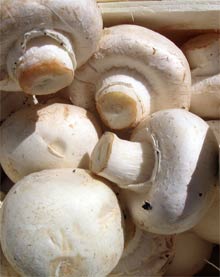Biofuels: Beyond Corn
In an attempt to find cheaper and more efficient routes to biofuels, researchers are turning to genomics. Scientists at the Department of Energy (DOE) have just selected the button mushroom as one of their latest picks for DNA sequencing, hoping to co-opt fungi’s plant-degrading power to produce ethanol more cheaply. Efforts are also planned to sequence the genomes of the eucalyptus tree and foxtail millet, a grass closely related to switchgrass.

Most ethanol in the United States is derived from corn kernels, hence it consumes a valuable food and agricultural product. What’s more, growing corn is itself an energy-intensive process. Grasses, agricultural waste such as cornstalks, and even trees could potentially provide a better feedstock: they produce much more biomass per acre than corn with less energy expenditure. However, these plant sources of ethanol require extensive preprocessing to release sugars from the cellulose in them, making the procedure too expensive to compete with traditional gasoline or corn-based ethanol.
With current methods to make cellulosic ethanol, the plant matter is broken down with chemicals and a costly mixture of synthetic enzymes. In an attempt to find a cheaper method, the DOE’s Joint Genome Institute (JGI), based in Walnut Creek, CA, is sequencing the genomes of approximately 20 “biomass degraders,” such as the button mushroom, which feed off decaying plants by degrading the cell walls and then using the resulting sugars for energy. “By sequencing organisms involved in natural biomass breakdown, you can hopefully identify superior enzymes and reactions that could be incorporated into fermentation organisms to improve the process,” says Jonathan Mielenz, director of the Bioconversion Laboratory at Oak Ridge National Laboratory, in Oak Ridge, TN.
Scientists are also sequencing the genomes of various crops to spur efforts to engineer faster-growing and hardier plants for biofuel production. “The key to making [cellulosic ethanol] workable is getting the most biomass you can per acre of land,” says Jim Bristow, head of the community sequencing program at the JGI. “Understanding the traits that lead to rapid growth or growth in particular climates will be important as we improve all these biomass feedstocks.”
“I think the real push in the next few years will be translating genome information into something you can burn,” says Bristow. He likens current efforts to the early days of the Human Genome Project. “We thought it would translate to new drugs. That didn’t happen overnight, but it did happen,” he says. “The genomes of biomass feedstock, degrading organisms, and fermenters are going to affect the progression of the biofuels industry.”
The JGI’s latest sequencing list includes the eucalyptus, a fast-growing tree that scientists hope can supplement or replace corn as a feedstock for biofuels. Comparing this sequence with the genome of the poplar, the only tree to be sequenced to date, will help scientists interpret both sets of DNA.
“I think we’ll make rapid progress in the development of domestic energy crops,” says Gerald Tuskan, a plant geneticist at ORNL who led the poplar-sequencing project. “We have the advantage of witnessing the development that occurred in traditional agronomic crops, so we already understand a lot of plant development and gene modification.”
Keep Reading
Most Popular
Large language models can do jaw-dropping things. But nobody knows exactly why.
And that's a problem. Figuring it out is one of the biggest scientific puzzles of our time and a crucial step towards controlling more powerful future models.
The problem with plug-in hybrids? Their drivers.
Plug-in hybrids are often sold as a transition to EVs, but new data from Europe shows we’re still underestimating the emissions they produce.
How scientists traced a mysterious covid case back to six toilets
When wastewater surveillance turns into a hunt for a single infected individual, the ethics get tricky.
Google DeepMind’s new generative model makes Super Mario–like games from scratch
Genie learns how to control games by watching hours and hours of video. It could help train next-gen robots too.
Stay connected
Get the latest updates from
MIT Technology Review
Discover special offers, top stories, upcoming events, and more.